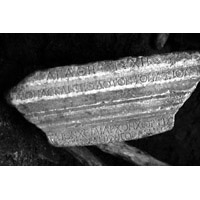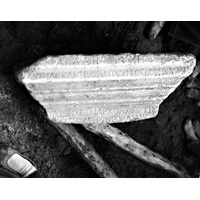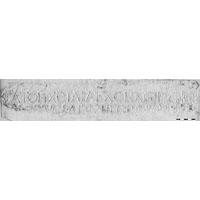 MAMA XI 28 (Eumeneia)
MAMA XI 28 (Eumeneia) 
Honorific statue-base for Aelius Asklepiodotos
- Type of monument:
- Honorific statue-base.
- Location:
- Emircik (Eumeneia): in a dungheap in the centre of the village.
- Description:
- Upper part of statue-base, broken below; lines 1-2 on the upper moulding, lines 3-4 on shaft.
- Dimensions:
- Ht. 0.30+; W. 0.76 (upper moulding), 0.52 (shaft); Th. --; letters 0.025-0.029.
- Record:
- Squeeze; line drawing; WMC notebook copy; photograph (1954/12).
- Publication:
- None; mentioned at PME V (Suppl. II) A23bis; Spaul 2000: 276-7; Thonemann 2011a: 154.
- Date:
- AD 238-244 (honorific title Gordiana).
ἀγαθῇ τύχῃ
[Α]ἴ̣λιον Ἀσκληπιόδοτον τὸν ἀξιολογώ̣-
τατον χειλίαρχον χώρτης
[π]ρ̣ώτης Ῥαίτων Γορδια
- - - - - - - - - - - - - - - - - -
With good fortune. [The council and the people? honoured] Aelius Asklepiodotos, the most worthy tribune of cohors I Raetorum Gordiana...







The history of the cohors I Raetorum is controversial. Overbeck 1981: 273-5 has argued that there were in the second century AD three homonymous cohorts (cohors I Raetorum in Raetia; cohors I Raetorum equitata civium Romanorum in Germania Inferior; cohors I Raetorum (equitata) in Moesia, Cappadocia and Asia); Spaul 2000: 276-8 attempts to combine all of these into a single, highly peripatetic unit.
Before the discovery of our inscription, the cohors I Raetorum (equitata) was already known to have had a period of cantonment at Eumeneia thanks to three undated inscriptions: (1) Ramsay, Phrygia II 380, no. 211 (IGR IV 736: Ἰούλιος Παπίας ἱππεὺς ὁπλοφύλαξ σπείρης πρώτης Ῥαίτων; on the office of armorum custos, see also MAMA XI 33 (1954/5)); (2) Ramsay, Phrygia II 381, no. 215 (IGR IV 729: Ἀντωνείνῳ στρατιώτῃ σπείρης πρώτης Ῥαίτων); (3) Ramsay, Phrygia II 381, no. 216 (IGR IV 728: [Π. Αἴ]⟨λ⟩ιον Φα[υστια]νὸν χε[ιλίαρ]χον χώ[ρτης] ἕκτης Ἱσ[πανῶν] καὶ χειλία̣[ρχον χ]ώρτης [πρώ]της ⟨Ῥ⟩αίτω[ν]). The date at which the unit was transferred to Eumeneia is uncertain. It was certainly stationed in Cappadocia in AD 135 (Arrian, Acies contra Alanos 1); the earliest clear evidence for its presence in Asia comes from a military diploma dated to AD 148 (Overbeck 1981; RMD 100, expanding Isaur(a) rather than Isaur(o)).
During the reign of Caracalla, members of the cohort formed part of the officium of the procurator Augusti provinciae Asiae at Ephesos (AE 1988, 1023, stratura militum c(o)hor(tis) I Raet(orum) qui in officio eius deputantur); cf. AE 1988, 1018 (same unit?), and Eck 1986. Presumably the cohort was, at least in the late second century AD, divided between Eumeneia and Ephesos. In AD 196, the cohort fort (castra) at Eumeneia was destroyed by an earthquake (MAMA IV 328; I.Denizli 21); the inscription which informs us of the earthquake has been attractively restored so as to refer to the cohors I Raetorum (Christol and Drew-Bear 1995: 64 [AE 1995, 1511]: castra [cohortis I Raeto]|rum terrae motu [conlapsa]). Our inscription shows that the cohort was still stationed at Eumeneia as late as the reign of Gordian III (AD 238-244). The later fate of the unit is unknown. On the history of the military presence at Eumeneia, see further Thonemann 2011a, Chapter 4.